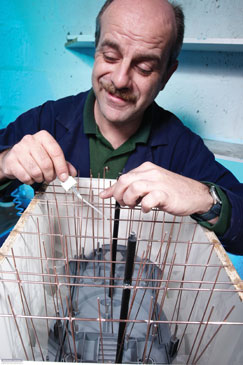Crossing the Irish Sea in search of a rapid prototyping and manufacturing bureau might seem a tad out of the way, but does such a service need to be on your doorstep?

The majority of the team have been with the company since its formation, and as such have a great deal of experience when it comes to the complexities of the finishing process
In an age where we’re quite happy to buy our music and books online (and our brides via dodgy ads in the back of a newspaper) when it comes to making prototypes it would seem that many businesses are missing out by not looking that little bit further afield for their services.
With a guaranteed next morning delivery to the UK, a wide range of specialist materials, and some of the most experienced heads in the business, Laser Prototypes makes a great case for UK companies to outsource their prototyping needs to the Emerald Isle.
“A lot of people view that stretch of water between Belfast and the mainland UK as a restriction,” states Laser Prototypes sales director Campbell Evans. “We’ve had to work with that concept from the start, so we’ve had to make sure we offer that level of customer service that is second to none to make sure that people realise that ‘working with a company in Belfast we can get the delivery, we can get the price, we can get the quality and service’.”
I am informed that quotes are currently turned around in “an average of one point-two hours”. The point-two raises a smile, but it goes to show how much the company believes in its own development.
From the many (confidential) projects on show in its workshop Laser Prototypes seems ideally positioned for a number of industries, none more so than the Irish medical giants and their subsequent offshoot companies. A few of these have resisted the recession and taken advantage of the medical certified SLA (Stereolithography) materials that Laser Prototypes offer.
“One thing that makes us stand out, and one thing that we progress regularly is the amount of materials that we’re running through the SLA,” says Campbell in his affable Belfast brogue. “With the interchangeable vat on the Viper machine it allows us to change resins on a regular basis, and we’re running seven totally functional SLA materials.

Using a prototyped part a silicon mould for vacuum casting is prepared
“One of those materials is the Watershed XC11222 which is the medically approved SLA material that has the USP grade six approval, and more recently the ISO approval, which is more relevant to UK business.”
With a number of customers using it for medical trials already, the material produces waterproof parts that look like clear, engineered plastic.
Starting out life in the early nineties offering parts built by one of the first SLA machines, Laser Prototypes is well aware that it needs to continually invest in technology to remain competitive and respond to market demands.
“You need the latest prototyping technologies,” says Evans. “You can’t buy a machine and just sit back on its laurels, you need to bring in the latest machines.
“When our customers required finer tolerances we brought in the Viper machine. When our customers required bigger and more accurate SLA models we brought in the new machines.”
The company now run the aforementioned 3D Systems Viper, a further SLA 3500 machine, as well as a an EOS P390 laser sintering machine.
Beyond prototyping
Despite being focused primarily on rapid prototyping the company offers a range of services from hand-finished models to low volume production runs.
“We’ve gradually brought on all the processes – stereolithography, selective laser sintering, vacuum casting, RIM, CNC, full painting and finishing – all done in house,” explains Evans.

Silicon mould inside Laser Prototypes’ vacuum casting machine
This suits the medical firms that are turning to Laser Prototypes to help produce not only the test parts, but the actual working machines, some of which can feature parts up to 1.5m in length.
“We work with several companies who require low volume production on the RIM [reaction injection moulding] side of things. We do that quite a bit on the medical field, where, for example, if you’re making a very big machine into which you’re putting extremely expensive electronic kit, you’re maybe going to only produce five each year to put into hospitals because they’re a million pounds’ worth of machinery,” says Evans.
“You’re not going to want to get tens of thousands of mouldings produced in China from a very expensive tool, and it’s ideal from us: With our reaction injection moulding we can produce the parts, paint them up and those will go into [the production model].”
For its UK customers Laser Prototypes might not be based just around the corner, and it’s a lengthy journey to pop in to check on a part in progress, but with consistency of results so deeply ingrained and an impressive next morning delivery service, this offshore company offers an impressive alternative to your local. Sometimes it can pay to look that little bit further away from home.

Laser Prototypes are changing the preconception that rapid prototyping needs to be done locally






